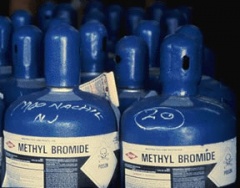Methyl Bromide
| Infobox on Methyl Bromide | |
|---|---|
| Example of Methyl Bromide |  |
| Facts | |
| Origin | - |
| Stowage factor (in m3/t) | - |
| Humidity / moisture | - |
| Ventilation | - |
| Risk factors | See text |
Methyl Bromide
Contents
Description
Bromomethane, commonly known as methyl bromide, is an organobromine compound with formula CH3Br. This colourless, odourless, non-flammable gas is produced both industrially and particularly biologically. It is a recognized ozone-depleting chemical.
It was used extensively as a pesticide until being phased out by most countries in the early 2000's.
Until its production and use was curtailed by the Montreal Protocol, bromomethane was widely applied as a soil sterilant, mainly for production of seed but also for some crops such as strawberries and almonds. In commercial large-scale monoculture seed production, unlike crop production, it is of vital importance to avoid contaminating the crop with off-type seed of the same species. Therefore, selective herbicides cannot be used. Whereas bromomethane is dangerous, it is considerably safer and more effective than some other soil sterilants. Its loss to the seed industry has resulted in changes to cultural practices, with increased reliance on soil steam sterilization, mechanical rogueing, and fallow seasons. Bromomethane was also used as a general-purpose fumigant to kill a variety of pests including rats and insects. Bromomethane has poor fungicidal properties. Bromomethane is the only fumigant allowed (heat treatment is only other option) under ISPM 15 regulations when exporting solid wood packaging (forklift pallets, crates, bracing) to ISPM 15 compliant countries. Bromomethane is used to prepare golf courses, particularly to control Bermuda grass. The Montreal Protocol stipulates that bromomethane use be phased out.
Bromomethane is also a precursor in the manufacture of other chemicals as a methylating agent, and has been used as a solvent to extract oil from seeds and wool.
Bromomethane was once used in specialty fire extinguishers, prior to the advent of less toxic halons, as it is electrically non-conductive and leaves no residue. It was used primarily for electrical substations, military aircraft, and other industrial hazards. It was never as popular as other agents due to its high cost and toxicity. Bromomethane was used from the 1920's to the 60's, and continued to be used in aircraft engine fire suppression systems into the late 60's.
Bromomethane is readily photolyzed in the atmosphere to release elemental bromine, which is far more destructive to stratospheric ozone than chlorine. As such, it is subject to phase-out requirements of the 1987 Montreal Protocol on Ozone Depleting Substances.
The London Amendment in 1990 added methyl bromide to the list of ODS to be phased out. In 2003 the Global Environment Facility approved funds for a UNEP-UNDP joint project for methyl bromide total sector phase out in seven countries in Central Europe and Central Asia, due for completion in 2007.
Many alternatives for Bromomethane in the agricultural field are currently in use and yet further alternatives are in development, not least of which include Propylene oxide and Furfural.











